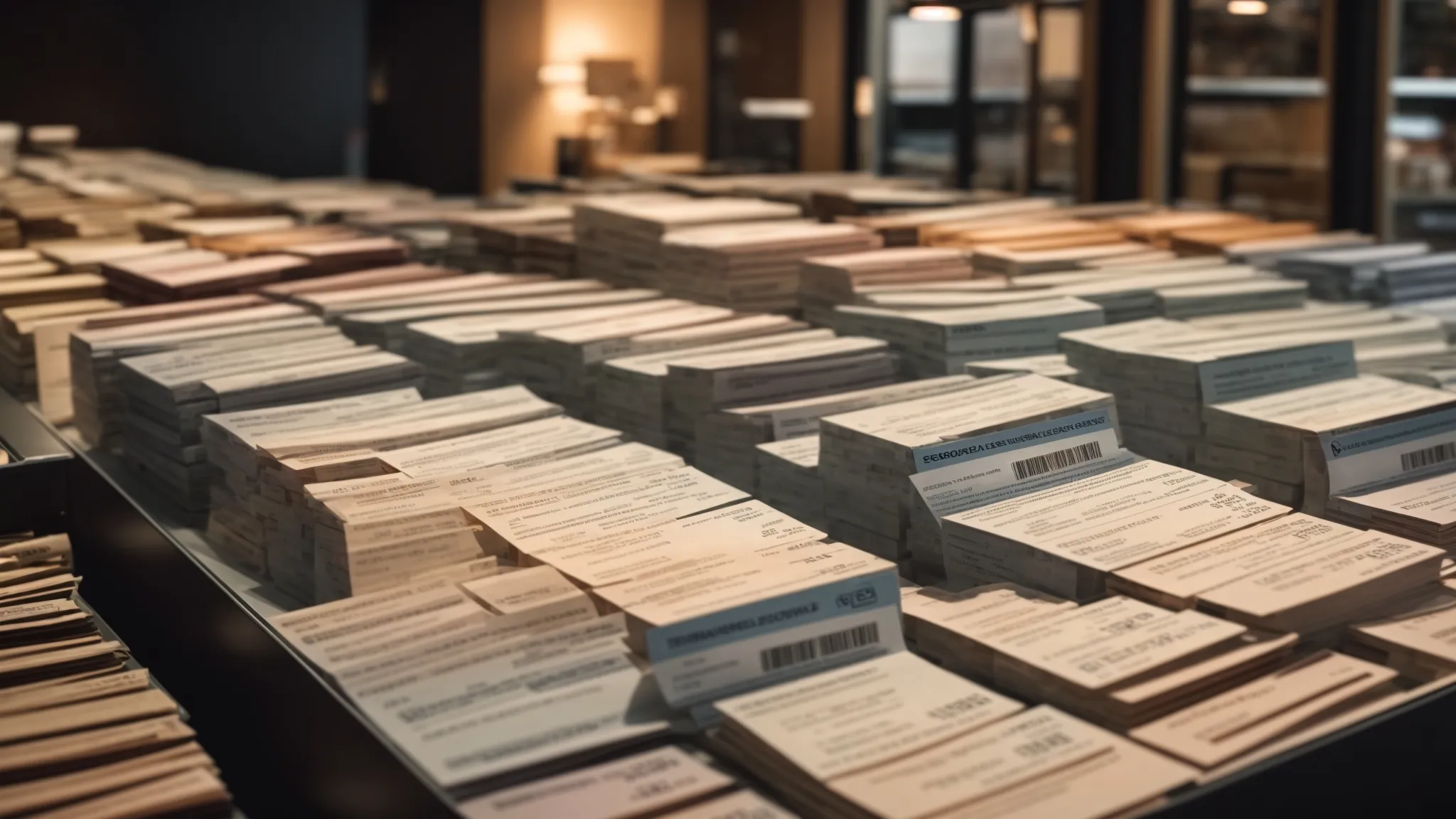Many small business owners struggle with effectively managing their cheque inventory, leading to inefficiencies and potential financial loss. This blog post will explore key techniques for efficient cheque inventory management, including abc analysis, procurement tips, and tools to streamline the process. By understanding these strategies, business owners can enhance their reputation by ensuring timely payments and avoiding stockouts. Engaging with this content will provide practical solutions to common inventory challenges, ultimately improving operations and sales in the retail sector.
Understanding Cheque Inventory Management

Cheque inventory refers to the management of both manual and computer cheques within a business. Effective cheque inventory management is crucial for maintaining operational efficiency, protecting a brand from fraud, and ensuring a smooth supply chain. Common challenges include tracking usage and preventing depletion. This section will explore these challenges and provide practical strategies to enhance cheque inventory management.
Defining Cheque Inventory and Its Importance
Cheque inventory encompasses the management of manual and computer cheques, crucial for any business’s financial health. An effective strategy in cheque inventory management can prevent stockouts, ensuring operational continuity and safeguarding income. Companies often implement a policy to monitor their cheque usage closely to avoid shortages that could disrupt their financial processes.
The shelf life of cheques influences how businesses handle their stock. Cheques that are not utilized within a certain timeframe can become obsolete, resulting in unnecessary waste and potential losses. By adopting proactive measures to manage cheque inventory effectively, businesses can optimize their resources and maintain smooth financial operations, fostering greater trust with clients and stakeholders.
Common Challenges in Managing Cheque Inventory
One of the primary challenges in managing cheque inventory is the risk of shortages or overstocking. Companies that fail to monitor their cheque usage effectively can encounter operational disruptions, impacting their accounting software processes and financial health. By tracking inventory levels and usage patterns, businesses can allocate resources more efficiently, reducing the likelihood of stockouts that could hinder financial transactions.
Additionally, aligning cheque inventory management with corporate social responsibility initiatives can pose its own set of challenges. Firms may overlook the environmental impact of producing excess cheques that go unused or expire. Ensuring a balanced approach in inventory management not only optimizes resources but also enhances brand reputation, demonstrating a commitment to sustainable practices while meeting business needs.
Managing cheque inventory well can save time and reduce stress. Next, let’s look at key techniques that will make this task straightforward and effective.
Key Techniques for Efficient Cheque Inventory Management

Implementing a regular audit schedule ensures businesses maintain optimal cheque levels, minimizing overhead costs and preventing shortages. Utilizing technology for real-time tracking allows for accurate inventory optimization based on demand. Additionally, categorizing cheques by type and usage enhances management efficiency, directly addressing customer needs and improving overall retail inventory management processes.
Implementing a Regular Audit Schedule
Implementing a regular audit schedule is an essential technique for managing cheque inventory effectively. This practice allows businesses to analyze cheque usage patterns and monitor the quantity of cheques on hand. By leveraging data analysis, companies can better align their cheque supply with operational cash requirements, ensuring they have sufficient stock to meet demands without overstocking, which can lead to waste.
Regular audits also enhance the overall merchandising of cheque inventory by providing insights into the most frequently used cheque types and their turnover rates. With accurate analytics, businesses can streamline their inventory processes, allowing for timely reorders based on usage trends. This proactive approach enables organizations to maintain optimal inventory levels, reducing the risk of disruptions in financial operations and supporting efficient cash flow management.
Utilizing Technology for Real-Time Tracking
Utilizing technology for real-time tracking enhances inventory control by providing businesses with immediate visibility into their cheque usage frequency. This clear understanding allows firms to make informed purchasing decisions, reducing the risk of overstocking or running out of cheques at critical moments. Streamlined monitoring can minimize expenses related to excess inventory, enabling companies to allocate resources more efficiently.
Advanced tracking systems can automatically alert businesses when cheque stock approaches predetermined thresholds, facilitating timely replenishment. This proactive approach ensures that businesses maintain an optimal balance of cheques, ultimately supporting smooth financial operations. By leveraging technology, companies can enhance their cheque inventory management strategy, reducing waste and improving overall operational efficiency.
Categorizing Cheques by Type and Usage
Categorizing cheques by type and usage enables businesses to gain better control over their cheque inventory management, leading to improved turnover rates. By establishing a checklist that differentiates between manual and computer cheques, companies can strategically allocate their assets, ensuring that the most frequently utilized cheques are always available. This targeted approach helps prevent shrinkage, as it minimizes the risk of stock being lost or wasted due to lack of oversight.
Vendor relationships can also benefit from this categorization effort. By understanding which types of cheques are in demand, businesses can communicate more effectively with suppliers, ensuring a consistent supply that meets their operational needs. This proactive management allows organizations to streamline their cheque ordering process, ultimately supporting efficient financial operations and mitigating potential disruptions.
Efficiency is key, but knowing how to keep a watchful eye on your cheque stock makes all the difference. Let’s uncover the best practices for monitoring cheque inventory, ensuring nothing slips through the cracks.
Best Practices for Monitoring Cheque Inventory

Setting up a reorder protocol for cheques ensures that businesses maintain an optimal ratio of stock, avoiding payroll delays or invoice processing setbacks. Establishing clear check issuance procedures alongside training staff on cheque management creates a reliable inventory system. These practices not only enhance operational efficiency but also contribute significantly to customer satisfaction by preventing disruptions in financial processes.
Setting Up a Reorder Protocol for Cheques
Establishing a reorder protocol for cheques is essential for effective inventory management. By leveraging automation and inventory management software, businesses can set predefined thresholds that trigger reorder notifications when stock levels fall below a certain point. This proactive approach not only ensures that cheques remain available but also aligns with regulatory compliance requirements, safeguarding the organization from potential disruptions in financial processes.
Integrating barcoding technology can further enhance the reorder protocol by streamlining tracking and inventory accuracy. As cheques are utilized, scanning them with barcode systems provides real-time updates on inventory levels, allowing companies to maintain safety stocks effectively. This combination of automation and precise tracking empowers businesses to optimize their cheque inventory management, reducing waste and ensuring availability for timely payments.
Establishing Clear Check Issuance Procedures
Establishing clear check issuance procedures is vital for driving efficiency in cheque inventory management. By implementing structured protocols, businesses can ensure that only authorized personnel issue cheques, helping to reduce the risk of errors or fraudulent transactions. Utilizing inventory management tools that track issuance patterns can provide insights into cheque usage, aiding in the determination of the economic order quantity to maintain optimal stock levels for sustaining revenue.
Training employees on these procedures enhances their understanding of the importance of accurate cheque management. Well-defined check issuance processes contribute to a smoother workflow, minimizing disruptions that could impact financial operations. With a focus on maintaining control over cheque distribution, businesses not only bolster their operational efficiency but also affirm their commitment to effective money management practices.
Training Staff on Cheque Management Processes
Training staff on cheque management processes is vital for any organization aiming to enhance its inventory turnover and overall efficiency. Well-informed employees ensure that procedures related to issuing cheques and processing purchase orders are followed accurately. This attention to detail not only minimizes errors but also strengthens the customer experience by ensuring timely payments and fewer disruptions.
Keeping track of cheque inventory is essential for smooth operations. Now, let’s look at the tools and software that can simplify this task and bring clarity to your management.
Tools and Software for Managing Cheque Inventory

Exploring features of cheque management software reveals essential tools that enhance security against theft and improve operational efficiency. Integrating accounting systems with cheque inventory not only streamlines processes within each accounting period but also fosters sustainability. Choosing the right software tailored to business needs can significantly boost return on investment while meeting consumer demands effectively.
Exploring Features of Cheque Management Software
Cheque management software significantly enhances visibility into the cheque inventory process, providing businesses with real-time insights into stock levels and usage patterns. Features like FIFO (First In, First Out) inventory control ensure that older cheques are utilized first, minimizing waste and optimizing resources. By integrating quality control measures within the software, organizations can ensure that they maintain high standards in cheque management, ultimately supporting consistent financial operations.
The inclusion of accounting functionalities within cheque management software further streamlines financial processes. By linking cheque issuance to accounting records, businesses can maintain accurate financial statements and improve oversight over their cheque-related transactions. This comprehensive approach to managing cheque inventory aids in the efficient flow of raw material through the financial system, ensuring that all elements of financial management work cohesively for better operational efficiency.
Benefits of Integrating Accounting Systems With Cheque Inventory
Integrating accounting systems with cheque inventory can significantly enhance a company’s workflow, ensuring that the reorder point for cheques is accurately maintained. This alignment allows for timely replenishment of stock, thereby reducing the risk of shortages that could disrupt financial operations. By having real-time visibility into cheque usage and cost of goods sold, businesses can make informed purchasing decisions that minimize waste, streamline their processes, and maintain an optimal inventory level.
Moreover, the combination of accounting systems and cheque inventory management helps businesses optimize their price strategies. By analyzing the financial data associated with cheque production and usage, organizations can identify trends and adjust their cheque purchasing accordingly. This informed approach not only maximizes returns by reducing unnecessary expenses but also supports a more efficient inventory management system that enhances overall operational effectiveness.
Choosing the Right Software for Your Business Needs
Choosing the right software for cheque inventory management is essential for maintaining optimal safety stock and ensuring smooth cash flow. An effective system should provide features that enable timely audits of cheque usage, helping identify patterns that could lead to stock shortages or excess. By selecting software that integrates well with existing systems, businesses can optimize their supply chain management, leading to more reliable cheque access when needed.
The ideal software also takes into account credit effectiveness by analyzing procurement trends and providing insights for better budgeting. A solution that accommodates the specific needs of a business, such as customizable stock levels and automatic reorder notifications, can significantly enhance operational efficiency. By prioritizing these functionalities, companies can ensure they are equipped to manage their cheque inventory proactively, reducing disruptions in financial processes.
With the right tools and software, businesses can streamline their cheque inventory process. Next, let’s look at real-world examples where these methods led to success, showing just what can be achieved.
Case Studies on Successful Cheque Inventory Management

This section analyzes successful strategies employed by leading companies in cheque inventory management. It addresses the formula for effectively aligning cheque supply with demand through advanced forecasting methods. Additionally, it covers lessons learned from common mistakes, highlighting the importance of maintaining an accurate balance sheet to enhance profit margins, and the role of mobile apps in optimizing inventory tracking.
Analyzing Strategies Used by Leading Companies
Leading companies in cheque inventory management often utilize advanced point of sale systems that seamlessly integrate with their cost accounting practices. By leveraging technology, these organizations can monitor cheque utilization in real-time, enabling them to maintain an optimal inventory. This proactive approach allows them to adjust their pricing strategies and product offerings based on actual usage patterns, ultimately minimizing waste and maximizing efficiency.
For example, a major retail chain implemented a sophisticated inventory tracking system, which provided insights into cheque turnaround rates linked to various pricing strategies. This system not only enhanced their inventory management but also supported their overall financial health by ensuring that cheques did not expire unused. As a result, businesses can learn from these practices to improve their own cheque inventory management and develop tailored solutions that address their specific needs and challenges.
Lessons Learned From Common Mistakes in Cheque Management
One of the significant lessons learned from common mistakes in cheque management is the necessity of accurate tracking and documentation. Businesses often face issues when cheque usage is not closely monitored, leading to either shortages or unexpected surpluses in stock. For instance, a company that neglected real-time tracking faced operational delays due to a lack of cheques available for timely payment processing, highlighting the importance of immediate visibility into inventory levels to prevent such disruptions.
Additionally, another mistake frequently observed is the failure to establish clear protocols for cheque issuance and reordering. Without defined procedures, discrepancies in cheque distribution can arise, creating confusion and potential fraud risks. Organizations that implemented structured issuance processes and coupled them with regular training for their staff experienced improved accuracy in cheque management, ultimately enhancing overall operational efficiency and fostering a reliable financial workflow.
The lessons learned from managing cheque inventory reveal deep insights. Now, let’s tackle the common questions that many face along the way.
Frequently Asked Questions on Cheque Inventory Management

This section addresses common inquiries regarding effective cheque inventory management. It will highlight the benefits of maintaining a sound cheque management system, outline security measures to protect inventory, provide guidance on actions to take if a cheque is lost, and recommend how frequently cheque inventory should be reviewed. These insights are crucial for optimizing financial operations and mitigating risks associated with cheque usage.
What Are the Benefits of Effective Cheque Management?
Effective cheque management offers businesses several benefits, primarily enhancing financial control and operational efficiency. By maintaining accurate tracking of cheque inventory, companies can prevent shortages or overstock situations that could disrupt their payment processes. This proactive approach enables timely payments, which in turn fosters positive relationships with clients and suppliers, ultimately supporting smoother business operations.
Moreover, a well-implemented cheque management system helps in mitigating the risk of fraud while ensuring compliance with financial regulations. Organizations that adopt strict protocols for cheque issuance and inventory monitoring can significantly reduce the likelihood of discrepancies and losses. This focus on security not only protects the company’s financial resources but also builds trust with stakeholders, highlighting the importance of effective cheque management in maintaining a company’s reputation and integrity.
How Do I Ensure Security in Cheque Inventory?
To ensure security in cheque inventory, businesses should implement strict protocols for cheque handling and storage. This includes restricting access to authorized personnel only and utilizing secure storage solutions, such as locked cabinets or safes, to protect against theft. Regular audits and reconciliations of cheque usage can also bolster security by helping organizations promptly identify any discrepancies or unauthorized transactions.
Incorporating technology further enhances cheque inventory security. Utilizing cheque tracking software that provides real-time visibility into inventory levels and issuance patterns allows businesses to monitor cheque usage closely. Additionally, employing features such as watermarking and specialized inks can deter forgery and bolster the integrity of cheques, safeguarding the organization from potential financial losses.
What Should I Do if I Lose a Cheque?
In the event of losing a cheque, the first step is to contact the bank immediately to report the loss. This action helps prevent unauthorized cashing by stopping payment on the lost cheque, protecting the organization from potential financial risk. Documenting all relevant details regarding the lost cheque, such as the cheque number, amount, and date of issuance, ensures that the bank has sufficient information to assist in the investigation.
Next, it is advisable to notify the recipient of the lost cheque to maintain transparency and discuss alternative payment methods. Should the lost cheque be subject to cancellation fees, reviewing the organization‘s cheque inventory processes can help mitigate future losses. Implementing improved tracking methods and a clearer cheque management protocol may further enhance security and efficiency in cheque inventory management.
How Often Should Cheque Inventory Be Reviewed?
Cheque inventory should be reviewed regularly to maintain optimal stock levels and prevent potential shortages or excesses. Most businesses benefit from conducting inventory assessments on a monthly basis, aligning with their accounting cycles to ensure that cheque usage is monitored effectively. This approach allows organizations to spot trends in cheque utilization, making it easier to adjust reorder levels accordingly.
Additionally, a consistent review of cheque inventory helps organizations identify discrepancies early on, reducing the risk of operational disruptions. By establishing a routine for inventory checks, businesses enhance their control over cheque management, ensuring timely payments and reinforcing financial stability. These reviews can also inform any necessary training for staff on best practices in cheque handling, further optimizing overall efficiency.

